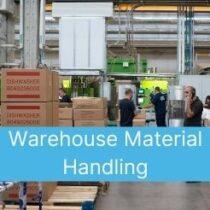Warehouse Layout Design: Everything You Need to Know
You’ve recently started a warehouse-related business but haven’t quite understood how to make it efficient. As you sit on your desk, you see the employees struggling to get work done due to poor layouts. Orders take a longer time to deliver and there are complaints from customers over delays. Your workers are unproductive and even fail to report to work most days due to frustrations. If you’re in the above situation, here is a guide on everything you need to know about a warehouse layout.
First, let’s explore the different phases of designing a warehouse.
Stages of Warehouse Designing
Truth be told; designing a warehouse can be a daunting process and you ought to have a clear plan of what you want to do and achieve at the end of the process. Here are the four stages you need to follow to get your efficient warehouse.
Initiation stage
There’s always a beginning to everything. Even for your warehouse design or redesigning, you need to identify the problem that needs solving.
For example, the location of products may pose a challenge to your employees making them take more time to move certain goods. You need to identify the fast-moving goods and place them closer to the exit so that the employees have a relatively easier time loading and off-loading.
To understand the problems your warehouse is currently facing, you need to consult with your employees. They could understand better the problems affecting their productivity. If you’ve fully automated your warehouse operations, you can also conduct an analysis of past data to detect inefficiencies.
Now after understanding the problems you need to address with the layout, you can get to the next stage.
Planning stage
We all know how difficult it can be to do anything without a plan. It’s more like igniting your vehicle and starting to drive without any specific direction or destination. Even when you want to design your warehouse layout, you’ve got to have a plan.
Now, you need to plan on the best layout guided by the problems you identified in the initial phase. At the planning phase, you want to make sure that you list the tasks you want to be completed at the end of the day. You also want to make sure that you create a plan of how the work will be executed and the timeframe. It is also at this point where you need to draft a map of the outcome you want with the warehouse. Finally, estimate the costs of each task required to complete the project.
Implementation stage
Now, this is the action phase! This is where you get things done. When executing the plan of your warehouse, you make use of the map you created in the planning phase. This is where you place goods in certain locations based on the need for their accessibility by employees. It is also the phase where you place special equipment such as refrigerators of course dependent on the goods you’re handling.
Closing Stage
After you’ve completed a task, it’s always advisable to sit down and reflect on the journey. What were the lessons? What were the most challenging parts? If asked to do it again, what would you do differently? It’s no different even when designing or redesigning a warehouse.
At this final stage, you get to evaluate the completed work. You want to make sure you document the problems solved and the lessons learned in the process. You also want to involve your employees so that you understand how the new layout has solved their problems. Besides, these notes will help you make future improvements to your warehouse layout if needed.
Now that we know the stages of warehouse design, let’s take a look at factors to consider to get your ideal layout.
Factors You Need to Consider When Creating a Warehouse Layout
Several factors come to play when you’re trying to come up with a warehouse layout. Each factor is important and may vary depending on the nature of operations within your warehouse. Now, let’s get to explore these factors!
Flow of Operations
You want to make sure that the layout plan takes into consideration how work flows. Each operation should remain as close as possible to the operation that precedes it. Likewise, each product that moves fast should remain as close as possible to the exit and so forth. Considering the flow of operations reduces time wasted moving from operation to operation.
If it’s possible to complete an operation in just 4 steps, why place such an operation 10 steps away? Get the drift? It makes it easier for the workers to move about and get work done in the shortest time possible. In the long run, productivity by employees means more return on investment on your end – a win-win situation!
Accessibility
It’s also essential to consider the accessibility of goods within your warehouse. Of course, several factors determine how you arrange your warehouse pallets. For example, if you deal with perishable goods, then you need to have a first expiry first out (FEFO) approach. Likewise, if you have some durable goods, make use of the first in first out (FIFO) approach. It, therefore, implies that you need to arrange the products such that they’re easily accessible for loading and unloading.
Space
When creating a warehouse design, you have to clearly know the amount of space you have. Space plays a major role because it determines the number of shelves you can install as well as the number of products you can have in the warehouse.
To run an efficient warehouse, you need to consider the available space and make maximum use of it. The most important storage operations should take up most of the space while functions such as offices should take minimal space. It’s also expected that in a warehouse you have some empty pallets most times. These pallets should be arranged in such a way that they occupy little space to leave room for the areas with stored goods.
Throughput
Throughput refers to how products are categorized to determine their flow. Fragile products should be placed in a certain area so that they don’t get damaged when loading or unloading. Throughput in warehouse layout also helps you depict peak times and low activity seasons so that you place products strategically for ease of flow of products.
Personnel
The number of employees you have and their level of training can also determine the layout of a warehouse. Within the design, you need to consider the space occupied by workers especially if you have many of them, and the shifts they work. As you do this, remember that a warehouse shouldn’t be crowded to avoid cases of theft or damage to goods.
The safety of employees also ought to be put into consideration. You need to have emergency tools, exits, and fire extinguishers in strategic locations within the warehouse.
Budget
Well, everything then trickles down to money! Your budget determines the design you can come up with. The budget also affects the level of automation within your warehouse. For example, if you want to have forklifts to minimize human workers, you equally need to spend more money to purchase them. Of course, having things like forklifts will help you get work done faster and use fewer employees.
Besides, the demarcation of different areas also incurs some costs. If you need cold rooms, it’s also an expense. The ventilation and air conditioning in the warehouse is also an important consideration because without it goods can easily go bad.
Parts of a Good Warehouse Design
Above, we mentioned that during the planning stage of warehouse design, you need to create a map. But, what should a warehouse design map contain? Here are some of the areas an effective warehouse should have marked.
- Loading and unloading areas
Loading and unloading areas are locations where distributors or suppliers load and unload goods from the trucks. These areas can be part of the main warehouse or detached and independent.
Having an independent area where loading and unloading occurs is beneficial in the sense that it reduces distractions to the other areas of the warehouse. However, independent loading and unloading areas pose the challenge of speed because moving products from point A to point B and that are independent can be time-consuming.
- Dispatch areas
Dispatch areas are sometimes located in the reception areas. However, for easier movement of goods, it’s important to have the dispatch area independent and to have it facilitate the loading of products into the trucks ready for delivery.
- Storage area
As the name suggests, this area is strictly meant for storage of goods. A warehouse manager can choose different methods of storage depending on the quantity and nature of goods being handled. The most common storage method is stacking boxes of goods using pallets in between stacks. Pallets help to strengthen the pile of boxes but only apply to goods with internal strength or those that are packaged using rigid packaging.
The main disadvantage of pallet systems is that, whenever you want to remove a box from a stack, you need to remove all the boxes and pallets on top of it. This makes it time-consuming but the most cost-effective method of storage nonetheless.
Other than the use of pallets, a storage area can also have braced beams. Beams form a cellular structure with slots where you can place boxes. The braced beams method of storage is more advanced because you need to make use of forklifts and you also have to spend more in the installation.
- Picking area
Depending on the layout of your warehouse, you can have a picking area integrated into the storage area. Most warehouses don’t require a picking area unless the goods need modification and preparation before being picked by distributors.
- Reception area
The reception is an important part of the warehouse because this is where all the verification of arrived goods takes place. At the reception, the staff counter-checks the products for quality control and labeling using barcodes.
- Service areas
Service areas include facilities such as bathrooms, support management, and areas to recharge batteries. To maximize space and efficiency, it’s important to have the service areas and offices as close as possible to the reception area.
Conclusion
In summary, a warehouse layout design is important if you want to have a smooth flow of work within the warehouse. The design should clearly indicate areas such as the loading and unloading, reception, dispatch, picking areas, and storage areas. To come up with a feasible warehouse design, you need to consider the number of employees you have, your budget, throughput, space, flow, and accessibility of the warehouse.



